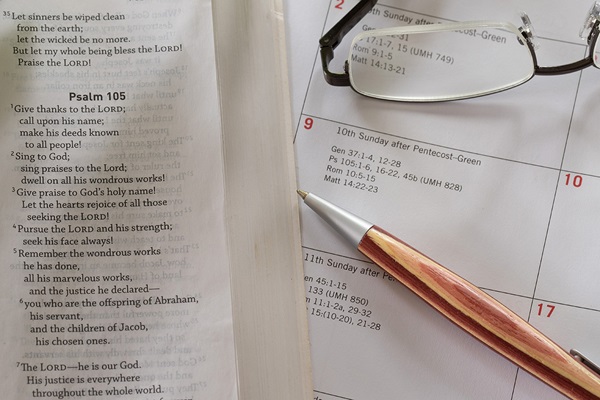A lectionary is a listing of readings from the Bible to be used on particular Sundays or days of the Christian Year. The early church created the Christian Year so the whole message of God's saving work in Jesus Christ would be heard throughout the year.
The first Methodist churches in the United States were given a lectionary to use by John Wesley, based on the one-year lectionary found in the 1662 Book of Common Prayer of the Church of England.
We do not know how well early Methodist elders in the United States followed the lectionary. We do know that in 1792 the General Conference dramatically cut Wesley’s Sunday Service, including its lectionary. From that time forward the instruction was to read one chapter out of both the Old and New Testaments each Sunday and for the sermon to be based on those readings. At that point Methodists in the United States shifted from having a lectionary (a specific list of readings) to a rule for scripture reading during public worship. German-speaking Methodists, who were part of what would become The United Brethren and The Evangelical Association, soon did the same.
Methodists in America would not have another lectionary for over 150 years. The 1945 Book of Worship reintroduced a full lectionary with two readings for each Sunday, a Gospel reading and almost always an Epistle reading. This one-year lectionary followed a pattern like the lectionary originally provided by John Wesley from the Book of Common Prayer.
The 1965 Book of Worship first introduced a full lectionary in the pattern we have it today, with an Old Testament Reading, a Psalm responding to it, a reading from one of the Epistles, and a Gospel reading for each Sunday. This Methodist lectionary perhaps best combined the form of the original lectionary and the intent of the 1792 General Conference that substantial readings from both the Old and the New Testament be part of worship each Sunday.
The 1965 lectionary, however, was still a one year lectionary and was fairly unique to The Methodist Church. That would mean if a congregation were using it, they would hear the same scriptures year after year, and therefore only a very limited set of readings overall. A congregation using it would hear the same limited set of scriptures year after year. Methodists may or may not hear the same scriptures as their Presbyterian, Lutheran, Episcopal, or Catholic neighbors on a given Sunday.
In 1969, the Second Vatican Council published a full three-year lectionary with many more readings than before. Protestant worship officers and leaders in the U.S. and Canada began to discuss how they might use the Catholic three-year lectionary as a basis for an ecumenical three-year lectionary. The Consultation on Common Texts, an ecumenical body with Catholic representatives from the U.S. and Canada, was created to take on the challenge. United Methodists were actively involved as members of the Consultation. Together they released a first version of The Common Lectionary in 1983, with the hope that churches and denominational leaders would try it over a period of at least two full cycles (6 years) and provide feedback about what worked, what didn’t work, and what would make the lectionary more useful. With that feedback in hand, the Consultation began work on what would become The Revised Common Lectionary, finalized in 1992.
Because of significant United Methodist involvement and the growing ecumenical commitments of the denomination, the 1988 General Conference authorized the inclusion of the Psalter of the Common Lectionary in the current hymnal (published 1989). And, as the lectionary was nearing its completion, the 1992 General Conference approved and recommended the use of a late draft of the Revised Common Lectionary as part of its proposed Book of Worship (published 1992).
Since the adoption of the Revised Common Lectionary, United Methodists have found it valuable in many ways. By using the Revised Common Lectionary, United Methodists share with other Christians the scriptures read each Sunday. These scriptures support the Christian Year, the church's underlying plan for inviting, forming, and sending disciples of Jesus Christ into the world. For more on how the lectionary and the Christian Year support discipleship, see "What is the purpose of the Church Year?"
Many United Methodist and ecumenical resources have been made to support the use of the lectionary, including music, preaching, and worship planning materials from Discipleship Ministries and Ministry Matters, preaching and planning manuals, the denominational program calendar, and Sunday School curriculum from Cokesbury, to name a few. And with many denominations using the Revised Common Lectionary worldwide, United Methodists who use it can find themselves learning and growing in common with many other Christians as well.
This content was produced by Ask The UMC, a ministry of United Methodist Communications.





